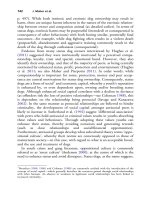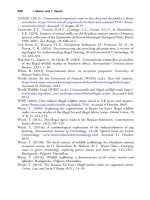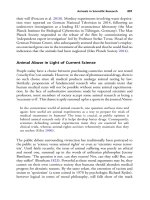The palgrave international handbook of a 144
Bạn đang xem bản rút gọn của tài liệu. Xem và tải ngay bản đầy đủ của tài liệu tại đây (28.47 KB, 1 trang )
Status Dogs
135
deemed dangerous. It is an offence for the person in charge of any dog (not
just banned breeds) to allow it to be ‘dangerously out of control’ anywhere—
in public or private space.5
Dog Fighting
Evans et al. (1998, p. 827) describe dog fighting as ‘the act of baiting two dogs
against one another for entertainment or gain’ and is an offence under the Animal
Welfare Act 2006. This is discussed in detail in the chapter on Animal Fighting,
but, in brief, there are three types of dog fighting. The first is organised, which
exists in the UK, but is more widespread in the USA (Ortiz 2010). The second
form, more prevalent in the UK, is ‘dog rolling’ or ‘chaining’. This is casual,
impromptu fighting between status dogs with young owners in public places that
may be filmed on mobile phones and is less likely to be motivated by significant
financial gain (RSPCA 2009, 2010). The third type is cultural, which lies between
the former two in terms of organisation. It has traditionally taken place in Pakistan
and rural Punjab and Kashmir, but has been ‘imported’ to the UK by young
Asians after they or their relatives have witnessed it in situ (Bassey 2009).
In sum, there is a lack of consensus around the definition of status dogs and
associated terms, and consequently, a lack of clarity around the identification of
these dogs. For example, are status dogs any bull breed accompanying a youth,
any dog owned by a gang member, any dog out of control or used for dog
fighting? What is clear is that the consequence of attributing the title of status dogs
to select breeds has amplified the harm they experience, as discussed forthwith.
Irresponsible Ownership of Status Dogs:
Nature of the Abuse
There are multiple harms caused by the irresponsible ownership of status dogs.
This section will identify the nature of legal and illegal harms at each point of
ownership: breeding, training, caring for, fighting, abandonment or killing of
5
The DDA was amended again in 2014 and, under section 3, it is now a criminal offence for the person
in charge of a dog to allow it to be ‘dangerously out of control’ anywhere—that is in a private place (e.g.,
a neighbour’s house or garden) or in the owner’s home, not just in a public space, as was the situation
previously. This extension to the law was a response to dog attacks in the home and on private property.
A dog is considered dangerously out of control if it injures someone or makes someone worried that it
might injure them. The recent Anti-Social Behaviour, Crime and Policing Act 2014 also contained a
number of clauses concerning dangerous dogs (see Bennett, 2016) including increased penalties.









